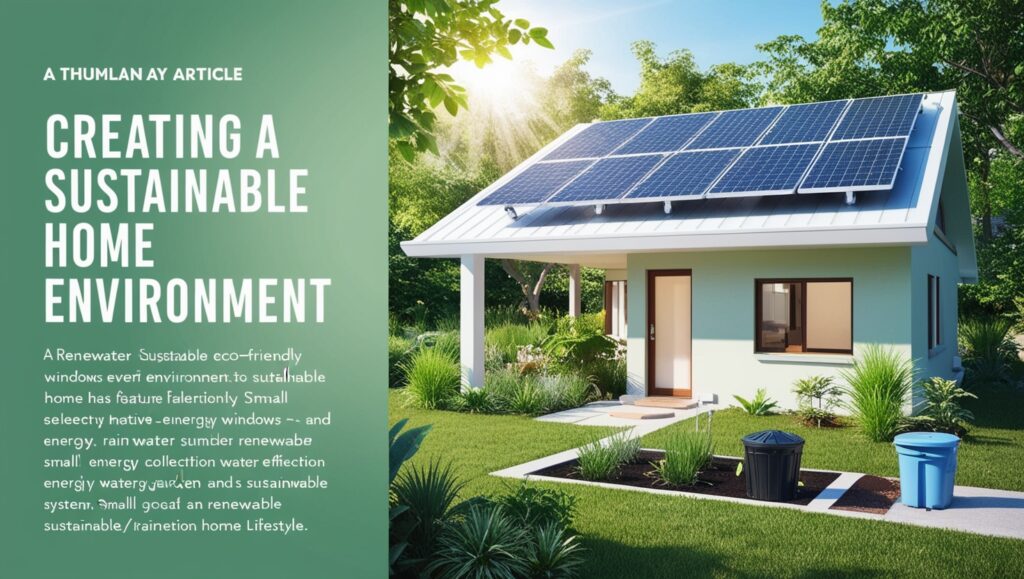Creating a Sustainable Home Environment: Simple Steps for a Greener Future
In today’s world, creating a sustainable home environment is more important than ever. As we face challenges like climate change, pollution, and resource depletion, making our homes eco-friendly is a practical step toward protecting the planet. A sustainable home not only benefits the environment but also enhances your quality of life by saving energy, reducing waste, and improving overall well-being. Here’s how you can transform your living space into a sustainable haven.
1. Energy Efficiency: Reducing Your Carbon Footprint
One of the most impactful ways to create a sustainable home is by improving energy efficiency. Start by assessing your household’s energy consumption. Simple changes can lead to significant savings:
- Switch to LED Lighting: LED bulbs use up to 75% less energy than traditional incandescent bulbs. They also last longer, reducing the need for frequent replacements.
- Install Energy-Efficient Appliances: Modern appliances with an Energy Star rating consume less energy and water. Replacing old refrigerators, washing machines, and dishwashers can significantly cut down on energy use.
- Use Smart Thermostats: A smart thermostat allows you to program your home’s heating and cooling systems to run only when needed. This reduces energy waste and lowers your utility bills.
2. Water Conservation: Preserving a Precious Resource
Water conservation is a key component of a sustainable home. Many households use more water than necessary, leading to wastage and increased utility costs. Here are some ways to reduce water consumption:
- Install Low-Flow Fixtures: Low-flow showerheads, faucets, and toilets use less water without sacrificing performance. These simple upgrades can reduce your water usage by up to 50%.
- Fix Leaks Promptly: Even small leaks can waste a significant amount of water over time. Check your plumbing regularly and repair any leaks as soon as they’re detected.
- Collect Rainwater: Installing a rainwater harvesting system can provide you with a free source of water for gardening and other outdoor uses. This reduces the demand on municipal water supplies.
3. Sustainable Building Materials: Choosing Eco-Friendly Options
When renovating or building a home, the materials you choose have a direct impact on the environment. Opting for sustainable building materials reduces the carbon footprint of your home:
- Use Recycled Materials: Recycled wood, metal, and glass are environmentally friendly options that reduce waste. These materials also add a unique aesthetic to your home.
- Choose Natural Insulation: Natural insulation materials like wool, cotton, and cellulose are renewable and have a lower environmental impact than synthetic insulation.
- Opt for Sustainable Flooring: Bamboo and cork are excellent alternatives to traditional hardwood floors. They are renewable, durable, and require fewer resources to produce.
4. Reduce Waste: A Zero-Waste Mindset
Adopting a zero-waste mindset can significantly reduce the amount of trash your household generates. Start by minimizing single-use items and focusing on recycling and composting:
- Compost Organic Waste: Kitchen scraps, yard waste, and other organic materials can be composted and used to enrich your garden soil. This keeps waste out of landfills and reduces the need for chemical fertilizers.
- Recycle Properly: Make sure you’re familiar with your local recycling guidelines and follow them closely. Sorting recyclables correctly ensures that they are processed efficiently.
- Avoid Single-Use Plastics: Invest in reusable alternatives to single-use plastic items like water bottles, grocery bags, and straws. This reduces plastic waste and helps keep oceans and landfills clean.
5. Sustainable Landscaping: Greening Your Outdoor Space
Your yard or garden can also contribute to a sustainable home environment. Sustainable landscaping practices reduce water use, support local wildlife, and minimize the need for harmful chemicals:
- Plant Native Species: Native plants are adapted to your local climate and require less water and maintenance. They also provide food and shelter for local wildlife, promoting biodiversity.
- Use Organic Fertilizers: Organic fertilizers and compost improve soil health without introducing harmful chemicals into the environment. They also support the growth of healthy, resilient plants.
- Mulch Your Garden: Mulching helps retain moisture in the soil, reducing the need for frequent watering. It also suppresses weeds and improves the soil’s nutrient content.
6. Renewable Energy: Powering Your Home Sustainably
Investing in renewable energy is one of the most impactful ways to make your home sustainable. Solar panels, wind turbines, and other renewable energy sources provide clean, renewable power:
- Install Solar Panels: Solar panels convert sunlight into electricity, reducing your dependence on fossil fuels. While the initial investment may be high, the long-term savings and environmental benefits are substantial.
- Explore Wind Energy: If you live in a windy area, a small wind turbine can generate enough electricity to power your home. This clean energy source reduces your reliance on the grid.
Conclusion: Small Changes, Big Impact
Creating a sustainable home environment doesn’t require major sacrifices or drastic lifestyle changes. By making small, intentional adjustments—like conserving energy and water, using sustainable materials, reducing waste, and investing in renewable energy—you can significantly reduce your environmental impact. These changes not only help protect the planet but also save you money and create a healthier living space for you and your family. Start today, and enjoy the benefits of a greener, more sustainable home!
See More


